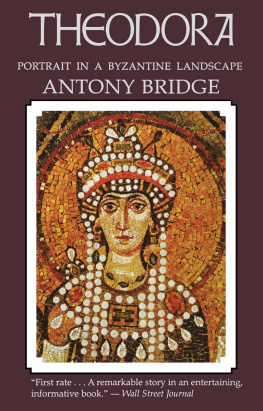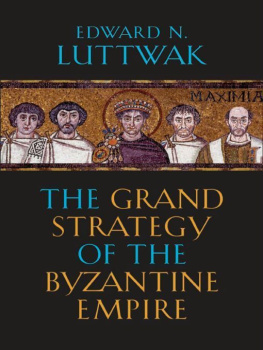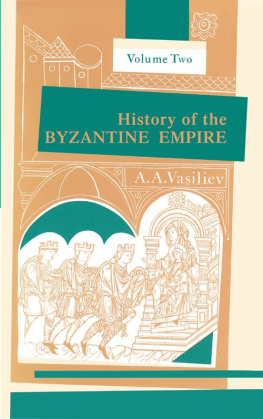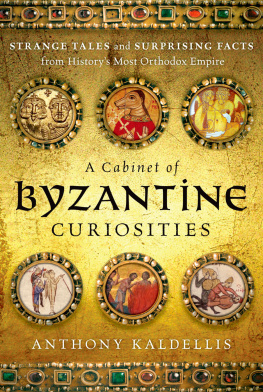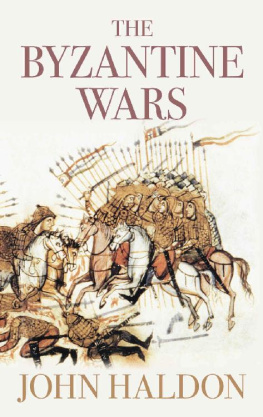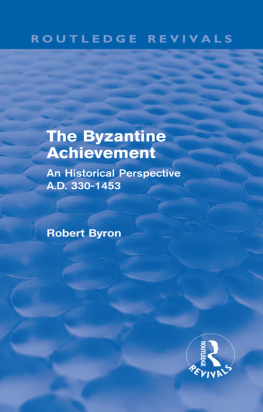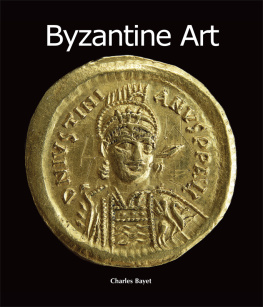Antony Bridge - Theodora: Portrait in a Byzantine Landscape
Here you can read online Antony Bridge - Theodora: Portrait in a Byzantine Landscape full text of the book (entire story) in english for free. Download pdf and epub, get meaning, cover and reviews about this ebook. year: 2005, publisher: Chicago Review Press, genre: History. Description of the work, (preface) as well as reviews are available. Best literature library LitArk.com created for fans of good reading and offers a wide selection of genres:
Romance novel
Science fiction
Adventure
Detective
Science
History
Home and family
Prose
Art
Politics
Computer
Non-fiction
Religion
Business
Children
Humor
Choose a favorite category and find really read worthwhile books. Enjoy immersion in the world of imagination, feel the emotions of the characters or learn something new for yourself, make an fascinating discovery.
- Book:Theodora: Portrait in a Byzantine Landscape
- Author:
- Publisher:Chicago Review Press
- Genre:
- Year:2005
- Rating:3 / 5
- Favourites:Add to favourites
- Your mark:
- 60
- 1
- 2
- 3
- 4
- 5
Theodora: Portrait in a Byzantine Landscape: summary, description and annotation
We offer to read an annotation, description, summary or preface (depends on what the author of the book "Theodora: Portrait in a Byzantine Landscape" wrote himself). If you haven't found the necessary information about the book — write in the comments, we will try to find it.
Theodora: Portrait in a Byzantine Landscape — read online for free the complete book (whole text) full work
Below is the text of the book, divided by pages. System saving the place of the last page read, allows you to conveniently read the book "Theodora: Portrait in a Byzantine Landscape" online for free, without having to search again every time where you left off. Put a bookmark, and you can go to the page where you finished reading at any time.
Font size:
Interval:
Bookmark:

Published in 1993 by
Academy Chicago Publishers
363 West Erie Street
Chicago, Illinois 60610
Copyright 1978 by Antony Bridge
First hardcover edition published by Academy Chicago: 1984
Printed and bound in the United States of America.
No part of this book may be reproduced in any form without the express written permission of the publisher.
Library of Congress Cataloging in Publication Data
Bridge, Antony.
Theodora: portrait in a Byzantine landscape.
Reprint. Originally published: London: Cassell, 1978.
Bibliography: p.
Includes index.
1. Theodora: Empress, consort of Justinian I, Emperor of the East, d. 548. 2. Byzantine EmpireHistoryJustinian I, 527565. 3. Byzantine empressesBiography. I. Title.
DF572.5.B7 1984 949.5.B7 1984 949.5010924 [B] 84434
ISBN 089733-394-2 (paperback)
Index
Photo section between pages
One of the most glaring gaps in most peoples knowledge is their almost total ignorance of the thousand years of Byzantine civilisation, without which neither western civilisation as we know it nor that of Russia and eastern Europe could have existed. They have heard of Constantine; they know that at some time or another he transferred the capital of the Roman world from Rome on the banks of the Tiber to Constantinople on the shores of the Bosphorus, though few of them have much idea of when or why he did so. Most people have also heard of Justinian, though they are very vague as to when he lived and what he did. Lastly, the name Theodora is faintly familiar and has slightly naughty associations; but that is all. The rest, as Hamlet said in a very different context, is silence.
This remarkable ignorance is at least in part the fault of Edward Gibbon, paradoxical as that may seem, for he wrote the first and in many ways the greatest history in the English language of Byzantine civilisation; but he was so blinded by the enlightenment of his age that, in the process, he misrepresented Byzantium and misjudged it more completely than anyone else, and was thus responsible for the universal contempt in which all things Byzantine were held for over a century, and the almost equally universal neglect with which they were treated. Happily, however, within the last hundred years there has been a change of heart amongst historians, many of whom have reassessed the Byzantine achievement, rejecting Gibbons judgement of it. At the same time, the ease of travel which everyone now enjoys and the excellence of modern means of reproducing paintings and mosaics in colour have led to the rediscovery of Byzantine art, which is probably more widely and deeply appreciated today than it has been since the days of men like Cimabue and Giotto, and this in its turn has led to a rebirth of curiosity about Byzantine civilisation and history. Unfortunately, this curiosity is not very easily satisfied; few people can return to the original Greek sources of information, even when they are easily accessible, which with a few exceptions they are not; meanwhile, most of the standard works on the subject in English, French, and German, let alone those in Russian, are either difficult to obtain or rather daunting in appearance by reason of their size, their obvious erudition, and sometimes their cost. So many ordinary, interested, and intelligent readers decide that Byzantine history is not for the likes of them; they would probably enjoy it greatly if they read it, but they seldom do so, and this is a pity.
Indeed, it is because I think it such a pity that I have written this book, which is intended for the person who would like to know more about the civilisation of which Byzantine art was the mirror and the people of whose hopes and dreams and beliefs it was the expression and the glory. To get to know a civilisation you can do one of two things; you can take a sweeping birds-eye view of it, or you can focus your historical telescope on one period of it in all its variety, colour, and living detail. It is probably a good idea to do both, but you can only do one or the other in a single book, and I have chosen to look at the life and times of Theodora in as much detail as is available, partly at least because there is so much of it; for the events of her life and time are extremely well documented. Her contemporary, Procopius, a brilliant if at times violently prejudiced historian, who copied the style of Thucydides, left a mass of detailed information about her personally and about the events of her day in a large number of works, and he was by no means the only man to do so. Several other Greek historians, notably John Malalas, covered the same period, as did the Syriac historian John of Ephesus. Their works, as well as a mass of other contemporary documents of one kind or another, have been the sources to which all modern historians have returned, and the results of their labours have been legion. I have listed many of these modern histories, both of the particular period covered by this book and of Byzantine civilisation in general, in the bibliography at the end of this book, but I must acknowledge here my debt to two men: the French historian, Charles Diehl, whose biography, Thodora, Impratrice de Byzance, together with his history of her time, Justinien et la civilisation byzantine au VIe sicle, and his many other works are still invaluable, even though most of them were published sixty or more years ago, and Diehls equally great English contemporary, J. B. Bury, whose Later Roman Empire is not only a classic but also a mine of information about the life, times and contemporaries of both Justinian and Theodora. Of course, I am in the debt of many others too, but they must forgive me if I do not mention them all by name here.
As for my own book, it is in no way a work of original scholarship, as any historian will be able to see at a glance; I have picked the brains of other scholars and raided their works unmercifully, and I am grateful to them for the wealth of detailed information and local colour which they have provided. If my book manages to rouse the enthusiasm of some people for the Byzantines and their achievements, and thus encourages them to take a greater interest in one of the worlds greatest, yet most misunderstood and undervalued civilisations, I am sure that its real historians will forgive me for raiding their territory and invoking their assistance in the process.
A.B.

 Each year on a day in late August or early September, the storks of northern Europe, western Russia, and the Ukraine rise into the air on great black and white wings, almost as if they had been given a signal to do so, and begin their journey to Africa where they spend the winter. In their tens of thousands they converge on the Bosphorus, until the sky above the narrow waters which separate Europe from Asia is filled with birds wheeling and soaring on the thermals of late summer as thick as motes of dust in a sunbeam. In A .D. 500, far below them on the triangle of land between the Golden Horn and the Sea of Marmara, lay Constantinople. Its houses, with their red-tiled roofs warm in the sun, were interspersed with parks and gardens, orchards and green fields; its streets and squares and forums stretched three miles westwards to the most formidable city wall the world had ever seen, running from sea to sea right across the peninsula. No doubt then as now, at a lower level than that at which the storks flew, the ubiquitous Byzantine pigeons circled in a noisy flurry of wings, and scavenging kites hung on the hot air in search of food, while the sounds made by a city of three-quarters of a million inhabitants rose up above the house-tops like the sound of a distant sea. A few noises stood out sharply from the groundswell: dogs barking in the distance, children calling and laughing as they played together, a donkey braying somewhere as if in pain, and down by the sea and the harbour the noise of men hammering or shouting the price of fish.
Each year on a day in late August or early September, the storks of northern Europe, western Russia, and the Ukraine rise into the air on great black and white wings, almost as if they had been given a signal to do so, and begin their journey to Africa where they spend the winter. In their tens of thousands they converge on the Bosphorus, until the sky above the narrow waters which separate Europe from Asia is filled with birds wheeling and soaring on the thermals of late summer as thick as motes of dust in a sunbeam. In A .D. 500, far below them on the triangle of land between the Golden Horn and the Sea of Marmara, lay Constantinople. Its houses, with their red-tiled roofs warm in the sun, were interspersed with parks and gardens, orchards and green fields; its streets and squares and forums stretched three miles westwards to the most formidable city wall the world had ever seen, running from sea to sea right across the peninsula. No doubt then as now, at a lower level than that at which the storks flew, the ubiquitous Byzantine pigeons circled in a noisy flurry of wings, and scavenging kites hung on the hot air in search of food, while the sounds made by a city of three-quarters of a million inhabitants rose up above the house-tops like the sound of a distant sea. A few noises stood out sharply from the groundswell: dogs barking in the distance, children calling and laughing as they played together, a donkey braying somewhere as if in pain, and down by the sea and the harbour the noise of men hammering or shouting the price of fish.
Font size:
Interval:
Bookmark:
Similar books «Theodora: Portrait in a Byzantine Landscape»
Look at similar books to Theodora: Portrait in a Byzantine Landscape. We have selected literature similar in name and meaning in the hope of providing readers with more options to find new, interesting, not yet read works.
Discussion, reviews of the book Theodora: Portrait in a Byzantine Landscape and just readers' own opinions. Leave your comments, write what you think about the work, its meaning or the main characters. Specify what exactly you liked and what you didn't like, and why you think so.

